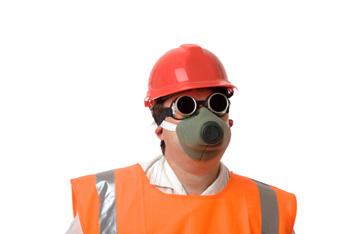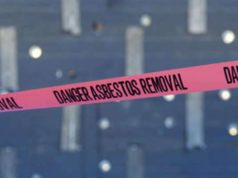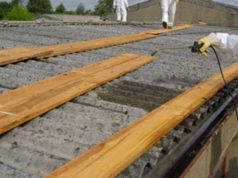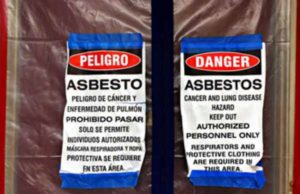
What is Asbestos?
The United States Environmental Protection Agency defines asbestos as a mineral fiber commonly used in several building construction materials. The mineral is utilized for its fire-retardant and insulating properties. Because of asbestos’s fiber strength, the mineral was widely used to bolster a number of manufactured goods, including buildings materials (floor tiles, roofing shingles, ceiling tiles, cement products and paper products), friction materials (automobile clutches, brakes and transmission parts), packaging, coatings, gaskets and fabrics.
When asbestos-containing particles are disturbed or damaged by repair, remodeling or demolition practices, microscopic particles propel into the air. These particles, which are carcinogenic in nature, become susceptible to inhalation. When inhaled, the fibers pose significant long-term health problems.
Prolonged exposure to asbestos fibers greatly increases your risk of developing lung disease. This risk is augmented by smoking and in general, the greater the exposure, the greater the chance of developing harmful side effects. Common asbestos-disease symptoms will take several years to become tangible. If you have worked with asbestos in the past it is essential that you visit a physician to undergo diagnostic or imaging tests. Early detection is typically the only means to combat asbestos-related cancers.
Exposure to airborne asbestos fibers increases the chances of developing cancers because the fibers stick to the lung lining and eat away at its protective tissues. Prolonged exposure to asbestos will increase the amount of fibers in the lungs. Fibers embedded in the lungs, over time, cause serious lung disease, including mesothelioma, lung cancer or asbestosis.
Three of the primary health effects associated with exposure to asbestos filaments includes the following:
Lung Cancer: This disease is the case of the largest number of asbestos-related deaths. Individuals who work in the milling, manufacturing or mining of asbestos, or those who use the deadly mineral and its products face a greater risk of developing lung cancer than the general population. Common symptoms found in lung cancer patients are coughing and a distinct change in breathing. Other symptoms will include: persistent chest pains, anemia, hoarseness and shortness of breath.
Mesothelioma cancer: This is a rare form of cancer that is typically found in the lining of the lungs, chest, heart and abdomen. Mesothelioma cancer is directly linked to asbestos exposure. This disease, because of its slow-developing nature and innocuous cellular structure, will not show up until 30-50 years following the patient’s first exposure to asbestos fibers. Treatment for mesothelioma cancer is dependent on when the disease is located. Unfortunately, because of the aforementioned characteristics, the disease is rarely detected before proliferation occurs. When the disease spreads beyond its point of origin, mesothelioma is deemed inoperable. Advanced stage mesothelioma, therefore, may only be mitigated through the administration of palliative treatment methods, such as radiation, chemotherapy and/or minor surgery. If a patient is lucky enough to secure an early diagnosis for mesothelioma cancer, the individual may undergo curative treatment options that aim to extract the cancer from the body.
Asbestosis: This is a serious, long-term non-cancer disease of the lungs. Asbestosis is caused by inhaling the mineral’s deadly particles that irritate lung tissues, ultimately leading to a mass build-up of scar tissue. This scarring makes it difficult for oxygen to pass through to the blood. Common symptoms associated with asbestosis include: crackling sound in the lungs while inhaling, shortness of breath and chest pains. There is no effective treatment for this debilitating disease.
What is a Professional Asbestos Inspector?
A professional asbestos inspector is a certified asbestos agent responsible for inspecting suspicious areas (homes, commercial buildings or automobiles) of asbestos containing materials. An asbestos remediation, inspection or abatement specialist is a professional who has undergone appropriate training by an Environmental Protection Agency-approved course provider. All professional asbestos inspectors are required to successfully pass an examination on the regulations and safety procedures associated with asbestos inspection and removal.
The Environmental Protection Agency’s National Directory of Asbestos Hazard Emergency Response Act Accredited Courses provides information regarding training asbestos providers in five separate categories:
• Training Providers (both active and inactive, by name, government entity and identification number)
• Active NDAAC training providers
• Provider List to show all company name changes associated with a current list of asbestos training providers
• Environmental Protection Agency-approved state accreditation programs which show the status of all EPA accreditations by state. The lists–which are made available at this website–offer state agencies, consumers, federal entities and training providers a comprehensive starting point to identify licensure by locality or state to affirm that asbestos firms advertise licensing inspections and accredited remediation. Fraudulent advertising or behavior is punishable by incarceration or the administration of fines.
Prospective professional asbestos inspectors wishing to obtain licensing must complete a three-day training course which includes demonstrations of materials and techniques, as well as lectures promulgating appropriate asbestos inspection procedure. These courses also require at least one-half day of hands-on participation in asbestos inspection techniques (primarily how to fit a respirator over oneself) as well as a final written examination.
Once a professional asbestos inspector attains accreditation from a licensed training agency, the asbestos professional is permitted to identify asbestos by use and location. Moreover, once licensing is secured, the professional asbestos inspector is able to identify asbestos materials by physical characteristics. Asbestos professionals, once licensing is secured, are also aware of the adverse health effects of airborne asbestos exposure, the latency periods attached to all asbestos-related diseases (such as asbestosis and malignant mesothelioma cancer) and the correlation between smoking and the proliferation of said diseases. Professional asbestos inspectors will also understand the legal liabilities associated with asbestos exposure, negligent removal of asbestos products and liability relating to asbestos project. Licensing courses will also enlighten a professional asbestos inspector as to how asbestos claims are filed for adjudication and settlement of all asbestos-related injuries and diseases. These licensed individuals are well versed in cooling and heating systems and how they may disturb asbestos materials. All professional asbestos inspectors are required to attend four hours of refresher classes each year to maintain their accredited status.
Contacting a Professional Asbestos Inspector:
When you contact a licensed asbestos inspector, he or she will work with a licensed removal or remediation specialist to complete an asbestos inspection project. This team of asbestos professionals will also identify asbestos materials in a home or commercial property. Through their knowledge, this team will suggest effective removal or remediation plans.
Some states in the U.S. provide asbestos licensing and training. For example, Minnesota, whose asbestos remediation regulations are less stringent. In Minnesota, an individual seeking certification must exhibit that he or she has either 500 hours of related field work in asbestos-related work, building inspection, industrial hygiene, hazardous materials controls or construction safety protocols. Prospective asbestos professionals in the state of Minnesota, in addition to the above requirements, may complete an apprenticeship program in one of a number of commercial construction trades specifically approved by the Minnesota Division of Voluntary Apprenticeship or the state’s Department Labor and Industry. In all states in the U.S., prospective asbestos inspectors must be state-licensed as a building official or possess a B.S. in engineering, architecture, safety or industrial hygiene and at least 40 hours of on site asbestos inspection achieved under a certified asbestos inspector. These requirements are accompanied by a mandate stating that applicant must have successfully taken a state-approved initial or refresher training course in asbestos identification within the previous calendar year.
These requirements demonstrate that while, Environmental Protection Agency-approved certification and training in asbestos inspection is formally recognized by every region in the United States, state certification programs will be equally as stringent in affirming that a licensed asbestos inspectors understands what needs to be done to protect a homeowner from the dangers of asbestos fibers.
More Information on Professional Asbestos Inspectors:
An asbestos remediation and inspector specialist will often belong to a union. Some of the larger asbestos inspector unions include: The National Asbestos Workers Union (AWIU) and the United Asbestos Inspector Organization. The former asbestos union was organized in 1903 in St. Louis, Missouri; this union was formed by skilled broiler mechanics to shield workers from asbestos insulation associated with boilers. The union, to this day, still works to expose the dangers of airborne asbestos exposure. Because of their efforts, the Environmental Protection Agency placed a wide-spread ban on the use of asbestos insulation in homes and commercial buildings. The union also serves as a formal checkpoint against commercial asbestos remediation companies which demonstrate poor performance or a lack of skill.
What to do When Hiring a Professional Asbestos Inspector:
If you hire a professional asbestos inspector you must verify that the inspection will include:
• The professional must collect samples of the suspected area following a thorough visual examination of the suspected area
• The professional must undertake in a remediation plan
• The professional asbestos inspector must conduct an evaluation of the dangers and the location of the asbestos
• The professional asbestos inspector must conduct a thorough laboratory analysis of asbestos samples. When the laboratory work is finished, you should request to see the actual report in writing.
In addition to the above suggestions you must also insure that the asbestos inspector will make frequent visits to the site to determine that the contractor is following the asbestos inspection plan correctly. A final visit is required to insure remediation is completed and that no asbestos has infiltrated the air or contaminated other areas of the house or building. This trip must be guaranteed in your contract.
Again, insure that you do not use the asbestos inspection firm to remove or remediate the asbestos containing materials in your home. Separate firms must be hired to avoid a conflict of interest. Failure to hire separate firms will result in negligence and mounting costs arising from unnecessary work. Also, you must verify for yourself that your asbestos contractor is following all of the EPA’s asbestos recommendations with regards to suitable remediation procedures. The contractor must utilize appropriate asbestos equipment and cleanup methods.
Lastly, the United States Consumer Product Safety Commission—a non-profit agency—is a government agency that protects the American public from injury or death from consumer products. Therefore, if you have been injured as a result of your asbestos project, you should contact the CPSC at 800-638-2772.





























